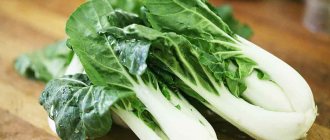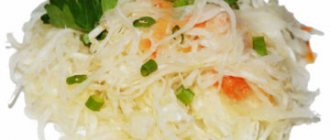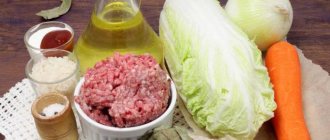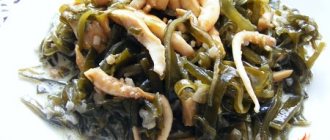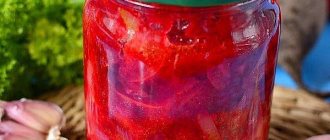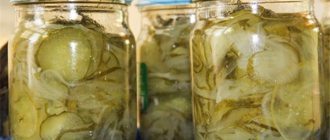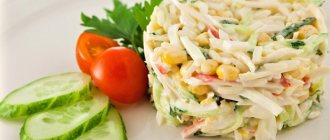Kale, or kale, is an unusual variety of cabbage that has escaped genetic modification and domestication. During World War II in France, Jerusalem artichoke saved people from hunger and vitamin deficiency. At the same time, in England it was cabbage of this variety that helped prevent people from starving to death. Kale, like Jerusalem artichoke, acquired the title of “forgotten vegetable” for many years. Nowadays, it is returning to tables thanks to popular restaurants that actively use the leaves to prepare their dishes.
Name and homeland of Kale
Curly cabbage has more than one name. It is also called kale (the emphasis is on the second syllable), brunkol, braunkol, grunkol. But no matter what the vegetable is called, it looks the same in any case: its fringed leaves can have a purple or green tint, and they do not form a head. That is why in Latin the name of the product is Acephala or Brassica oleracea, which means “unattached, unattached.” This variety has a high stalk, sometimes reaching one meter, from which the leaves spread loosely in all directions. Scientists are confident that grunkol is the most ancient type of wild cabbage.
Brauncoli manages to grow even under the most extreme climatic conditions. After suffering frosts, it turns out even juicier and sweeter. In Europe, curly cabbage was the most popular green vegetable until the end of the Middle Ages. Many countries cultivated the leaf, but over time other crops replaced the vegetable. When this variety was remembered again, it was already considered exotic, especially in our latitudes.
But, nevertheless, not a single state considers itself the birthplace of grunkol. Cabbage is loved in all countries, but everywhere it is considered brought from another country. The Germans call kale a French crop, in England it is widely believed that this cabbage comes from Scotland or Siberia, and for the Dutch it is a German “subject”. In the UK and USA, kale appears under the name Red Russian kale - Red Russian cabbage. They say that merchants from Russia brought the leaves to America on ships, after which the product firmly established itself in California gardens. Trade relations between Arkhangelsk and London contributed to the second coming of kale to England.
Interesting facts about kale
- For much of the 20th century, kale was used primarily for decorative purposes in the United States. The fashion for eating it appeared only in the 1990s, when attention was again paid to its dietary and medicinal qualities. Hollywood stars include kale in their daily menu. For example, actress, producer and singer Gwyneth Paltrow, as well as other famous film artists, claim that the secret of their unfading youth and slimness lies in kale juice. And British model Rosie Huntington-Whiteley starts every morning with a smoothie made from this amazing vegetable.
- Ornamental kale varieties are just as edible as other varieties, but potentially not always palatable. Their leaves are often used as an ingredient in gift and wedding bouquets.
- Raw kale contains 84% water, 9% carbohydrates, 4% protein and 1% fat. The nutritional value of a 100-gram serving is 49 calories.
- When cooked in boiling water, kale loses most of its anti-cancer properties. However, cooking food in the microwave, steaming or frying does not cause significant loss of medicinal qualities.
- Famous Tuscan soups: ribollita, farinata, minestra, minestrone and other traditional Italian dishes are prepared from black Tuscan kale varieties: 'Nero di Toscana', 'Cavolo di Nero', 'Cavolo di Palmisio'.
- In the northern part of Germany, especially around the cities of Bremen, Oldenburg, Osnabrück and Hanover, gastronomic and culinary festivals dedicated to kale are held from October to February. During the festive events, the “king” or “queen” of kale is chosen from the circle of famous compatriots. For example, German Chancellor Angela Merkel and former Federal President Christian Wulff were once given these honorary titles in the hope that they would champion local interests during their regency.
- In Scotland, kale has become such a traditional food that in some dialects the word "kale" is synonymous with the word "food".
- Various varieties of kale, called kai-lan or Gai-lan in China, Taiwan and Vietnam, are a common, everyday vegetable. In Japan and South Korea, cabbage juice called "Aojiru" is used as a vitamin-healing food supplement.
- Kale cabbage leaves are picked for consumption when their length reaches 20 cm. And so on throughout the growing season until winter frosts. In place of the torn leaves, new ones grow.
Types of brauncolleaf cabbage
Kale has many varieties:
- Siberian cabbage is a variety resistant to low temperatures and various pests.
- Reed - its height can reach almost two meters. The peculiarity of this species is that it has a heavy stem that can be used as a cane.
- Red Russian - has the same properties as Siberian, but is externally distinguished by the presence of twisting, expressive red leaves.
- Curly cabbage is the most common variety of kale (cabbage). It is distinguished from other varieties by its softer and sweeter taste. The leaves of the crop have a wrinkled and curly appearance.
- Redbor F1 cabbage can be dark purple or red in color, so this variety is often used to give dishes certain tones.
- Tuscan cabbage is distinguished by elongated thin leaves that have a wrinkled structure.
- Premier cabbage is a frost-resistant, fast-growing variety.
Whatever the variety of kale (kale), it is best to eat its leaves raw, adding them to salads with young garlic, tomatoes and basil. In this way, the beneficial properties of the crop will be preserved much better.
Composition of bruncole cabbage
Kale contains many minerals, folic acid, approximately 20% magnesium, calcium, copper and potassium. Curly cabbage, a photo of which can be seen in our article, is enriched with vitamins A and C. Approximately 50% of them are found here. The culture contains vitamins B1, B2, B6, and E in slightly smaller quantities.
The product also contains vitamin K, which is extremely important for the human body. Provitamin A (beta-carotene) is also included in kale. The product contains 85% of the daily dose of the substance. One hundred grams of brown cabbage contains 28 kcal.
Mineral and vitamin composition
Curly kale is a storehouse of minerals; it contains folic acid, magnesium, calcium, potassium, copper, phosphorus, sodium, and selenium. This culture is also rich in vitamins C, E, B1, B2, B6, A. Vitamin K contained in browncol is also very important for the body, since it helps normalize the process of blood clotting and also neutralizes poisons.
Kale contains Omega-3 essential fatty acids and active substances with antioxidant properties. In addition, browncol contains a protein consisting of 18 amino acids. By eating kale on fasting days, you don’t have to worry about saturating your body with protein, because 200 g of this plant is equal in protein content to a serving of beef. Nutritionists advise completely replacing meat dishes with kale, especially if there are contraindications to eating meat.
Article on the topic: Greek Doricnium - beneficial properties, description
Useful properties of bruncole cabbage
Curly cabbage has a number of positive properties, for which it is necessary to grow this vegetable. The product helps eliminate calcium deficiency. One gram of cabbage contains about 1.35 milligrams of this substance, while the same amount of milk contains only 1.13 milligrams. Calcium from this cabbage is absorbed by the body 25% better than calcium from milk. For people who suffer from milk protein intolerance, kale is an invaluable source of calcium.
Due to the increased content of vitamin C, bruncol is considered an excellent antioxidant of natural origin. The low calorie content of browncoli helps fight excess weight. Despite the minimal calorie content, the vegetable fully saturates the body with most of the essential substances. Therefore, vegetarians give culture a place of honor in their diet menu.
Kale is considered an unsurpassed substance for the prevention of vision. The culture is called the queen of carotenoids, since one cup of the product contains 200% of the daily value of vitamin A.
Cooking Kale
Bruncol serves as a wonderful ingredient for many dishes. Kale (recipes below) can be a component of salad or soup. You can make a delicious salad from the young leaves of the vegetable. To create it you will need eight small leaves of cabbage, one hundred grams of feta cheese, one glass of red currants (gooseberries, raspberries, black currants, grapes or apple slices), a little cold-pressed olive oil, a quarter glass of quinoa, parsley, dill, green onions to taste .
Washed and dried kale leaves should be cut into thin strips. Then finely chop the onion and herbs, beat some of the berries in a blender. Mix berry puree with salt, olive oil and pepper. Now combine the cereal, herbs, onions and cabbage in a bowl and mix the salad with berry dressing. It is recommended to decorate the top of the dish with pieces of cheese and remaining berries.
To prepare soup with cabbage grunkol you should prepare:
- One hundred ml of cream.
- One glass of chicken or vegetable broth.
- 400 g frozen peas.
- White pepper, salt.
- One potato.
- 200 g kale.
- Two tablespoons of grated Parmesan cheese.
- One or two sprigs of mint.
- Three or four sprigs of basil.
Peel the potatoes and cut into large pieces. Boil potatoes and peas in two containers. Combine the boiled products with chopped cabbage leaves and broth and beat everything with a blender. Add chopped basil and mint leaves, Parmesan, cream to the puree and place the container with the soup on low heat. Stirring all the time, heat the dish for two minutes. The dish is served with crackers.
Storing kale cabbage and photos
Select kale leaves when they are still small and young - yellowing leaves are not suitable for the kitchen.
Look at the photo of kale - this is how fresh, edible kale leaves look like. Use them immediately after collection. Collard greens can be stored in a plastic bag in the refrigerator for up to 3 days, as long-term storage increases bitterness. The leaves can be chopped and frozen in a bag.
Very young, tender kale leaves are suitable for eating raw. They can be chopped into a mixed salad or served with a lemon dressing.
Planting a crop
As a rule, the crop is grown from seeds that are planted in open soil. Curly cabbage, the seeds of which need to be planted in mid-April or early May, does not tolerate transplantation well. Therefore, it is better not to touch the sprouts that have already emerged from the soil. The soil temperature for seeds should be 50 degrees. In each hole you need to add a little humus with wood ash.
Curly cabbage (kale) grows very quickly. Seeds germinate on the fifth to seventh day after planting. At home, the crop is grown from seedlings.

